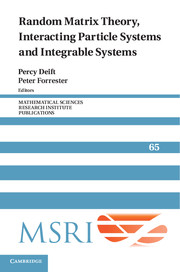Book contents
- Frontmatter
- Contents
- Preface
- Universality conjecture for all Airy, sine and Bessel kernels in the complex plane
- On a relationship between high rank cases and rank one cases of Hermitian random matrix models with external
- Riemann–Hilbert approach to the six-vertex model
- CLT for spectra of submatrices of Wigner random matrices, II: Stochastic evolution
- Critical asymptotic behavior for the Korteweg–de Vries equation and in random matrix theory
- On the asymptotics of a Toeplitz determinant with singularities
- Asymptotic analysis of the two-matrix model with a quartic potential
- Conservation laws of random matrix theory
- Asymptotics of spacing distributions 50 years later
- Applications of random matrix theory for sensor array imaging with measurement noise
- Convolution symmetries of integrable hierarchies, matrix models and τ-functions
- Universality limits via “old style” analysis
- Fluctuations and large deviations of some perturbed random matrices
- Three lectures on free probability
- Whittaker functions and relatedstochastic processes
- How long does it take to compute the eigenvalues of a random symmetric matrix?
- Exact solutions of the Kardar–Parisi–Zhang equation and weak universality for directed random polymers
- Replica analysis of the one-dimensional KPZ equation
- Asymptotic expansions for β matrix models and their applications to the universality conjecture
- KPZ scaling theory and the semidiscrete directed polymer model
- Experimental Realization Of Tracy–Widom Distributions And Beyond: Kpz Interfaces In Turbulent Liquid Crystal
- Random matrices: the four-moment theorem for Wigner ensembles
Riemann–Hilbert approach to the six-vertex model
Published online by Cambridge University Press: 29 May 2025
- Frontmatter
- Contents
- Preface
- Universality conjecture for all Airy, sine and Bessel kernels in the complex plane
- On a relationship between high rank cases and rank one cases of Hermitian random matrix models with external
- Riemann–Hilbert approach to the six-vertex model
- CLT for spectra of submatrices of Wigner random matrices, II: Stochastic evolution
- Critical asymptotic behavior for the Korteweg–de Vries equation and in random matrix theory
- On the asymptotics of a Toeplitz determinant with singularities
- Asymptotic analysis of the two-matrix model with a quartic potential
- Conservation laws of random matrix theory
- Asymptotics of spacing distributions 50 years later
- Applications of random matrix theory for sensor array imaging with measurement noise
- Convolution symmetries of integrable hierarchies, matrix models and τ-functions
- Universality limits via “old style” analysis
- Fluctuations and large deviations of some perturbed random matrices
- Three lectures on free probability
- Whittaker functions and relatedstochastic processes
- How long does it take to compute the eigenvalues of a random symmetric matrix?
- Exact solutions of the Kardar–Parisi–Zhang equation and weak universality for directed random polymers
- Replica analysis of the one-dimensional KPZ equation
- Asymptotic expansions for β matrix models and their applications to the universality conjecture
- KPZ scaling theory and the semidiscrete directed polymer model
- Experimental Realization Of Tracy–Widom Distributions And Beyond: Kpz Interfaces In Turbulent Liquid Crystal
- Random matrices: the four-moment theorem for Wigner ensembles
Summary
The six-vertex model, or the square ice model, with domain wall boundary conditions (DWBC) has been introduced and solved for finite n by Korepin and Izergin. The solution is based on the Yang–Baxter equations and it represents the free energy in terms of an n × n Hankel determinant. Paul Zinn-Justin observed that the Izergin–Korepin formula can be expressed in terms of the partition function of a random matrix model with a nonpolynomial interaction. We use this observation to obtain the large n asymptotics of the six-vertex model with DWBC. The solution is based on the Riemann–Hilbert approach. In this paper we review asymptotic results obtained in different regions of the phase diagram.
1. Six-vertex model
The six-vertex model, or the model of two-dimensional ice, is stated on a square lattice with arrows on edges. The arrows obey the rule that at every vertex there are two arrows pointing in and two arrows pointing out. This rule is sometimes called the ice-rule. There are only six possible configurations of arrows at each vertex, hence the name of the model; see Figure 1.
We will consider the domain wall boundary conditions (DWBC), in which the arrows on the upper and lower boundaries point into the square, and the ones on the left and right boundaries point out. One possible configuration with DWBC on the 4 × 4 lattice is shown on Figure 2.
The name of the square ice comes from the two-dimensional arrangement of water molecules, H2O, with oxygen atoms at the vertices of the lattice and one hydrogen atom between each pair of adjacent oxygen atoms. We place an arrow in the direction from a hydrogen atom toward an oxygen atom if there is a bond between them. Thus, as we already noticed before, there are two in-bound and two out-bound arrows at each vertex.
Figure 1. The six arrow configurations allowed at a vertex.
Figure 2. An example of a 4 x 4 configuration (left) and the corresponding ice crystal (right).
For each possible vertex state we assign a weight wi, i =1, ...., 6, and define, as usual, the partition function, as a sum over all possible arrow configurations of the product of the vertex weights,
where Vn is the n × n set of vertices,σ (x)∈{1,...,6} is the vertex configuration of σ at vertex x according to Figure 1, and Ni (σ) is the number of vertices of type i in the configuration σ.
Information
- Type
- Chapter
- Information
- Publisher: Cambridge University PressPrint publication year: 2014
